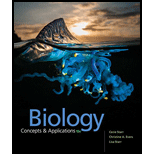
Biology: Concepts and Applications (MindTap Course List)
10th Edition
ISBN: 9781305967335
Author: Cecie Starr, Christine Evers, Lisa Starr
Publisher: Cengage Learning
expand_more
expand_more
format_list_bulleted
Concept explainers
Textbook Question
Chapter 7, Problem 7SA
After the citric acid cycle reactions run _________, one six-carbon glucose molecule has been completely broken down to
| a. once | b. twice | c. six times | d. twelve times |
Expert Solution & Answer
Want to see the full answer?
Check out a sample textbook solution
Students have asked these similar questions
After the citric acid cycle reactions run________ , one six-carbon glucose molecule has been completely broken down to CO2. a. once b. twice c. six times d. twelve times
Which of the following citric acid cycle intermediates is decarboxylated during the operation of the cycle?
A. More than one correct response
B. No correct response
C. Isocitrate
D. Succinate
E. Oxaloacetate
The ATP produce in the citric acid cycle is by substrate-level phosphorylation. *
A. True
B. False
Chapter 7 Solutions
Biology: Concepts and Applications (MindTap Course List)
Ch. 7 - Is the following statement true or false? Unlike...Ch. 7 - Glycolysis starts and ends in the ________. a....Ch. 7 - Which of the following pathways requires molecular...Ch. 7 - Which molecule does not form during glycolysis? a....Ch. 7 - In eukaryotes, the final reactions of aerobic...Ch. 7 - Prob. 6SACh. 7 - After the citric acid cycle reactions run...Ch. 7 - Prob. 8SACh. 7 - Prob. 9SACh. 7 - Prob. 10SA
Knowledge Booster
Learn more about
Need a deep-dive on the concept behind this application? Look no further. Learn more about this topic, biology and related others by exploring similar questions and additional content below.Similar questions
- The citric acid cycle produces _____ ATP molecule(s) per glucose molecule:a. 1b. 2c. 4d. 16arrow_forwardWhich of the following statements is true about the citric acid cycle a. The Citric Acid Cycle is an 8-step cycle that produces the most electron carrier molecules throughout the process of cellular respiration. b. In Citric Acid Cycle, both the acetyl group and coenzyme A of Acetyl CoA are combined to oxaloacetate. c. In Citric Acid Cycle, glucose is only partially broken down and there are still remnants of glucose after this process. d. The ATP produced during this process is via oxidative phosphorylationarrow_forwardThe Citric Acid Cycle takes the molecule of acetyl CoA and generates ________ per glucose molecule. Group of answer choices A. 3 ATP B. 2 NADH, 4 ATP C. NADH, 2 ATP D. 6 NADH, 2 FADH2, and 2 ATParrow_forward
- identify the reactions of the citric acid cycle that provide reducing power for the electron-transport chain a. conversion of succinyl-CoA to succinate b. conversion of fumarate to malate c. conversion of succinate to fumarate d. conversion of malate to oxaloacetatearrow_forwardEach turn of the citric acid cycle directly produces ________. a. 2 carbon dioxide molecules b. 2 ATP molecules c. 3 NADH and 1 FADH 2arrow_forward1. Answer the following questions: a. A substance produced from pyruvate that is a precursor in the citric acid cycle and in the formation of glucose is? a. ketoglutarate b. oxaloacetate c. lactate d. malate e. fumarate b. In the early fasting stage, glucose for the brain and red blood cells are supplied by reserves. C. phosphorylation produces 2 ATP, phosphorylation produces a lot of ATParrow_forward
- during oxidative phosphorylation, one FADH2 produced by the krebs cycle will produce a. 1 ATP b. 2 ATP c. 3 ATP d. 4 ATP e. 5 ATParrow_forwardThe final outputs of the citric acid cycle include all of the following except what molecule? a. CO2 b. ATP c. Oxaloacetate d. FADH2 e. NADParrow_forwardThe conversion of citrate to isocitrate is catalyzed by an enzyme classified as a(n): a. Hydrolase b. Oxidoreductase OC. Isomerase Od. Transferasearrow_forward
- Which of the following can undergo metabolic conversion to acetyl CoA and enter the citric acid cycle? A. Fatty acids B. All of the choices are correct. C. Protein D. Glucosearrow_forwardFatty acids are catabolized by a process called beta-oxidation. One of the products of beta- oxidation is acetyl CoA. Given this information, the products of beta-oxidation will most likely be incorporated into which stage of cellular respiration? A the citric acid cycle B C D glycolysis oxidative phosphorylation the link reactionarrow_forwardThe glycolytic pathway occurs in the and most of the citric acid cycle takes place in the cell membrane, cytosol A. B. Cytosol, cytosol c. cytosol, mitochondrion D. Cytosol, mitochondrial membrane mitochondrial membrane, cytosol E.arrow_forward
arrow_back_ios
SEE MORE QUESTIONS
arrow_forward_ios
Recommended textbooks for you

Anaerobic Respiration; Author: Bozeman Science;https://www.youtube.com/watch?v=cDC29iBxb3w;License: Standard YouTube License, CC-BY